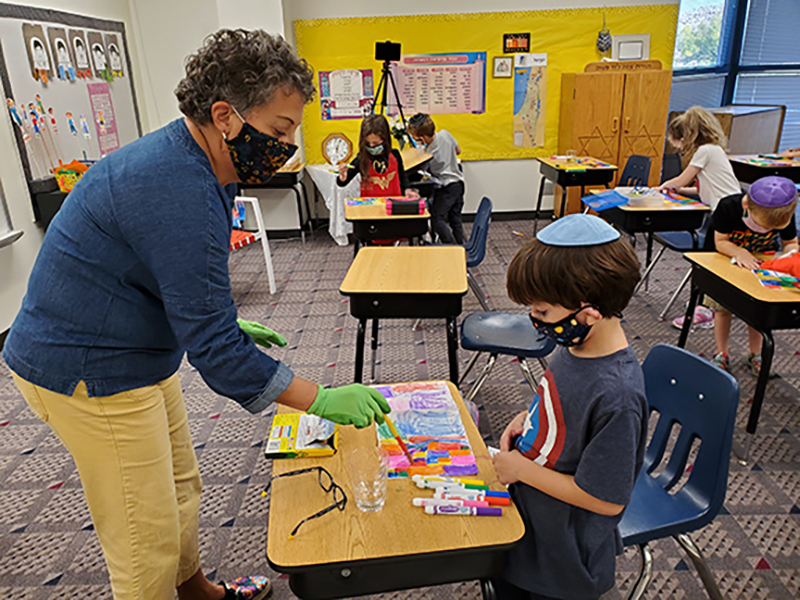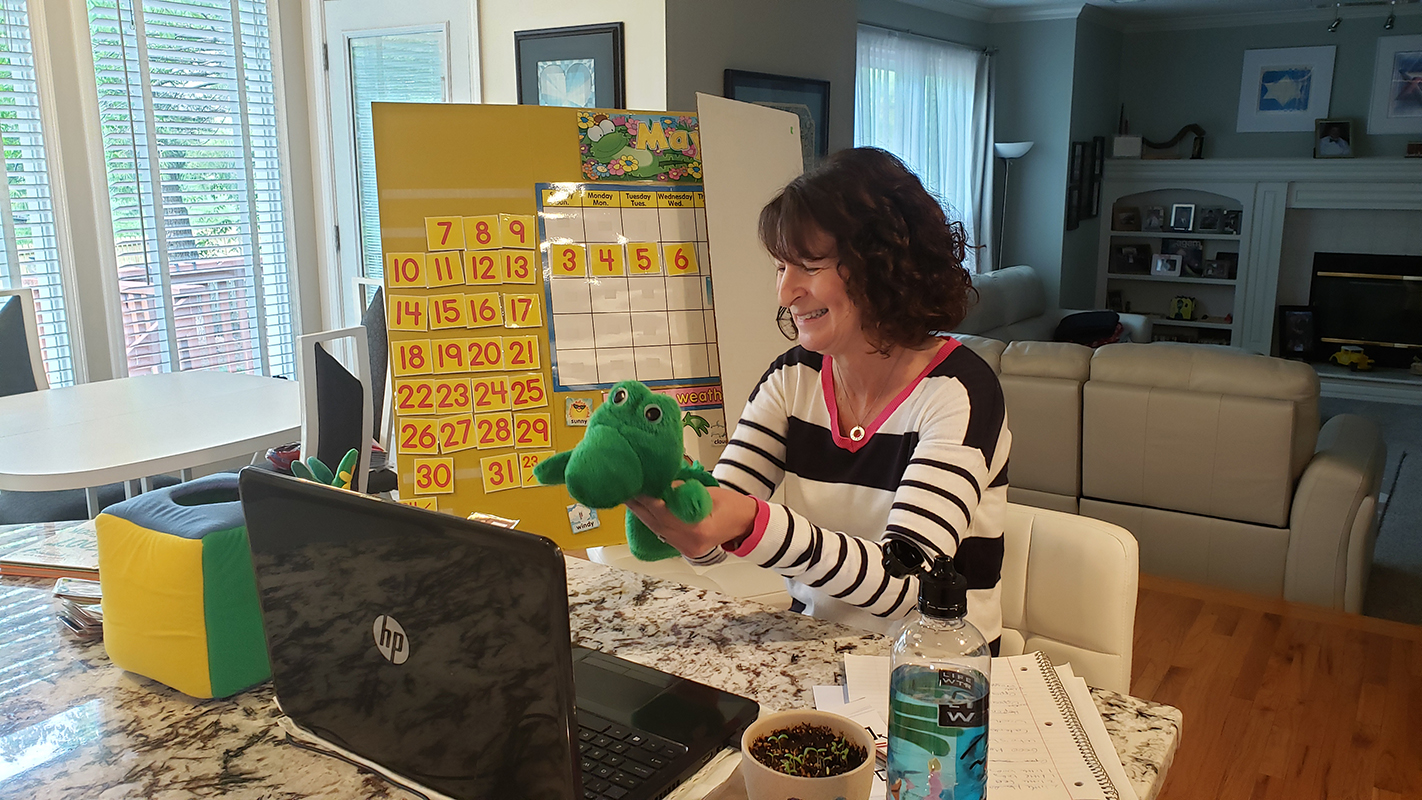At its virtual annual meeting Wednesday, Jewish Federation of Greater Kansas City honored all of our community’s Jewish educators for the ways they adapted to meet students’ needs. In a video shown during the meeting, education professionals from across our community shared their experiences and thoughts on what they expect, and hope, from the year ahead. The educators’ responses are excerpted below.
To view the video, visit www.jewishkansascity.org/Educators.
Machaela Whelan, director, Child Development Center at The J
When the pandemic started, the CDC was considered essential and remained opened. It went to critical care, with a much lower capacity of teachers and students. Teachers began creating online content for the CDC YouTube channel and Zoom meetings to keep in contact with families.
“That was a lot to ask,” Whelan said. “We had in-person teachers and at-home teachers and they stepped up to the plate every single time I asked something new of them.”
Whelan said the pandemic highlighted things that need to change and ways that early childhood programs like the CDC need to continue to update and stay up with best practices in early childhood education.
“It’s an exciting time to think about how we can challenge our teachers, how we can challenge our families and how we can keep everyone involved in this really robust community that we’ve developed at the CDC,” she said.
Moving forward, Whelan hopes our community as a whole can stay strong.
“This has been a big challenge of every resource in the Jewish community, in our individual organizations, this has been a stressor on every single piece of that,” she said, “and I hope that we remain strong … and that we can remain a robust community.”
Micah Margolies, Hyman Brand Hebrew Academy middle and high school English and math teacher
What really makes Margolies proud of HBHA is the adaptability of the entire school community, from administrators to teachers, to the support staff, and students and parents.
“This has been a situation where there was no roadmap of what to do. We’ve had to constantly adapt on the fly and that means teachers have put in long hours, both individually and collaboratively, to learn new tools,” he said. “Some of these are teachers who have been teaching for 25 or 30 years who have well-established practices, things they’ve been doing for decades, and they’ve had to find new ways to teach and reach students in a completely new way.”
Even Margolies, as a younger teacher, had to find new ways of teaching that he had never thought of before. Not to mention the students had to find new ways to learn.
“Nobody wants to learn this way, but they’ve been enthusiastic and engaged and understanding that teachers are trying new things that sometimes don’t work,” he said.
While this has been a time of change for education, Margolies said there’s one thing that has stayed the same.
“The main thing that stays a constant is, regardless of whether I’m in person or online, the most important thing is making sure that I’m feeling connected with students, and connecting with them wherever we are,” he said.

Judy Jacks Berman, director of early childhood education, Beth Shalom Rose Family Early Childhood Education Center
When classes first went virtual, Berman sat in on all of them so she could offer feedback to teachers.
“By the end of the first week, every teacher had it down and the students were focused and learning and enjoying it,” she said.
At first, students didn’t know they were supposed to talk to their teachers through the screen, but by the third day even the 20-month-olds understood when they were being asked questions and needed to respond.
Last summer and fall, Beth Shalom gradually transitioned from virtual to socially-distanced activities, hosting parking lot concerts and family blanket activities in the congregation’s large field. From there it went to outdoor pod activities (four kids to one teacher, with no pods mixing). Then they pivoted to indoor classrooms. That continued for almost two months until the COVID numbers spiked, so they shifted back to virtual learning.
“This time we realized when we did virtual, we really wanted it to be much more interactive,” Berman said. Each week, teachers dropped off a bag of activities, labeled by day, to do with students on Zoom.
Beth Shalom did virtual classes for the first week of school after winter break and then moved back to in-person learning for those families wanting it. For those who don’t feel comfortable sending kids back to school yet, Beth Shalom is offering virtual classroom activities.
Berman hopes they can continue moving forward with in-person classes and that she and her staff will get the vaccine soon as essential workers.
“I think that by the time this pandemic is over, we’ll go back to what we used to be, which is a large, thriving pre-school,” she said, “but right now we’re pretty low-key just to get through it.”
Michael Fine, Sunday school teacher at Congregation Beth Torah
Fine said the first step in transitioning to virtual learning was identifying what students needed: a safety valve for all the pressures they’re feeling and an opportunity to connect with a Jewish adult.
In order to facilitate those needs, Beth Torah shifted from the typical Sunday school model of two hours once a week to 20-minute time slots on Sundays that kids sign up for individually. Fine said that a lot of the time he just listens to how the kids are doing. They share their experiences, what they’re feeling, and talk about anything else going on.
“We devote a lot of time to “How are you and what do you want to talk about?” he said.
With the remaining time, Beth Torah teachers introduce a high-level Jewish concept and speak on it briefly. In the time between sessions, about two weeks, students are asked to observe how that concept appears in their lives, whether through an activity or questions they are given to answer.
This provides a safe relationship with the teacher, Fine said, keeps the students from getting bored, and they still have the opportunity to connect Judaism to their day-to-day lives.
In the next year, he hopes teachers and students don’t forget what they learned from this time of virtual education.
“This pandemic sped up the way we engage virtually, but everything is going virtual. There’s no way that the way we’ve done Sunday school for thousands of years … was not going to change by this digital revolution and all this new technology,” he said. “I hope in the next year we can continue to take these lessons from teaching virtually and we continue to engage them.”
Tom Barnett, confirmation class teacher at New Reform Temple
In February, New Reform Temple’s confirmation class took a trip to New York to see the variety of Jewish culture and synagogues there. The class came to an end once the pandemic hit, restarting in September on Zoom for the six students in the class.
Barnett said teaching virtually has gone well and the class has about a 90% attendance rate, but “Zoom is not the ideal way to have a discussion class.”
Something that’s become apparent is that, rather than just he and the rabbi lecturing students, they need to focus on interaction.
“When we do that, (the students) come back,” he said. “I think we’ve all learned the more we can have better interaction with the students, the better the class is, whether it’s on Zoom or whether it’s in person.”
Barnett is eager to get back to in-person confirmation classes, whenever that might be.
“I think it’s important because, the one thing that I find that is lacking is we limit our time on Zoom because of students being able to site for X number of hours, they’ve done this already,” he says, “so we don’t have the full amount of time we’d like for discussion of subjects that we’re concerned with.”
Paula Suroff, The Temple, Congregation B’nai Jehudah first-grade teacher
For Paula Suroff, a first-grade teacher at B’nai Jehudah, the idea of teaching virtual wasn’t a comfortable one at first.
“Being over 75, the whole online tech thing scared me, and it was a challenge,” she said. Her 13-year-old grandson became her helper, guiding her through the technical part of virtual teaching.
Once she got the hang of Zoom, the next thing was thinking about the lessons she was going to teach that were relevant to her age group and what’s going on in the world.
“I didn’t want to do esoteric Jewish teaching, because this is Zoom,” she said.
Her first lesson, for example, was about derech eretz (doing the right thing) and wearing a mask. She incorporated several activities, as she does with all her lessons, to make it engaging for the students. There was a downloadable color sheet where kids colored masks, she had them bring their favorite mask for show and tell, made up a song about masks and found a story to read about doing the right thing.
For now, classes at B’nai Jehudah are still completely virtual. Suroff is excited for the time when she and her students can be in the classroom together, and thinks this time of virtual teaching will make for better in-person teaching.
“Forcing us to really concentrate and focus on having a meaningful lesson on Zoom has really inspired each teacher — at least it did for me — to be more creative and innovative,” she said, “and I think when it comes back to when we’re in class, I will be a better teacher…”



